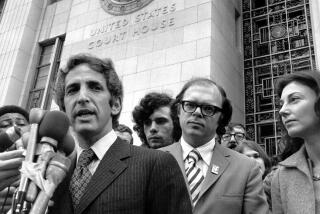Effort to Show Loss From Spying : Secret Agency’s Workings Described at Pelton Trial
BALTIMORE — Inner workings of the National Security Agency were described to a federal court jury Friday by the official in charge of collecting and analyzing Soviet communications for the super-secret agency.
The official, William Perry Crowell Jr., testified as the prosecution’s 14th and final witness in the trial of accused spy Ronald W. Pelton. He used pictures, charts and even audio tapes of four different communications signals--outlining his unit’s budget, mission and method of operation in an effort to show the importance of secrets that Pelton allegedly sold to the Soviet Union for $35,000.
Pelton, 44, is accused of telling the Soviets about a U.S. installation off the Soviet coast that intercepted Soviet military communications.
Wrote Secret Booklet
While a $24,500-a-year employee of NSA, Pelton in 1978 wrote a highly secret booklet called “Signal Parameters File,” which Crowell called a “compendium of technical information” about many of the Soviet signals collected by the United States.
Divulging such top-secret information, Crowell said, “could reasonably cause exceptionally grave damage” to the United States.
The harm comes because the breach “reveals the very fact that we can collect a particular signal,” Crowell said. He said if the Soviets were alerted to monitoring, they could “change the nature of the communication or change the value” of it.
Such “countermeasures,” he said, “would deprive us of the information on military matters that had previously been available.”
Says Damage Would Be Costly
These developments allow the Soviet Union “to be cost effective,” he said, and are “extremely costly” to the United States. The information could cause U.S. espionage efforts to be “rendered ineffective,” Crowell said.
Crowell’s appearance was marked by frequent interruptions as lawyers for both sides conferred with U.S. District Court Judge Herbert F. Murray and gingerly maneuvered around issues of national defense.
Nevertheless, Crowell’s testimony broke with the tradition of thick-walled mystery that surrounds the NSA. As an example of its secretiveness, NSA tells employees to say that they work for the Defense Department, not NSA, which is located at Ft. Meade, Md.
Crowell, chief of U.S. signal intelligence, said that his unit has “several thousand” employees and a budget of “several hundred million dollars per year.”
Defines NSA Mission
Its mission is to “intercept and exploit” radar, radio, light beams, wire and other communications, as well as to secure computer systems from unauthorized access, said Crowell.
Crowell, a 23-year NSA employee who has held several top positions within the agency, said that he “regularly” briefs Defense Secretary Caspar W. Weinberger and Central Intelligence Agency Director William J. Casey, as well as other senior officials at those agencies.
At times, the CIA passes on “requirements for information,” Crowell said, and then his agency decides which Soviet signals to monitor. He said NSA “samples” myriad signals around the world on a 24-hour basis.
At one point, Crowell, in professorial tones, gave the 12 jurors a primer on NSA signal collection, calling the process a “mosaic.”
Like Unscrambling TV Signals
He likened NSA installations to backyard television satellite dishes, adding that when people unscramble television signals it is like NSA’s decoding Soviet messages.
Later, Crowell gave details on top-secret projects identified in the trial only as Projects A, B, C, D and E.
He said:
--Project A is a “set of equipment” used to collect Soviet communications and “give us an insight into military forces, their relative sizes, their plans for maneuvers . . . “ This project is the one Soviets were most interested in getting details on in their “debriefings” of Pelton, prosecutors say.
--Project B “greatly increases the speed” of handling collected intelligence.
--Projects C and D are “collections from undisclosed locations.”
--Project E “concerns a specific Soviet signal.”
Crowell did not elaborate on the last three projects.
During cross-examination by Pelton’s attorney, Fred Warren Bennett, Crowell acknowledged that when Pelton indicated on a map for the FBI where he had identified the U.S. signal installation for the Soviets, Pelton was several hundred miles off.
Bennett said that Pelton would have known the exact location, based on his top-secret clearance, but the attorney did not pursue the point.
Bennett filed a motion for acquittal on two of the six counts facing Pelton. He will call the first defense witness Monday.
More to Read
Sign up for Essential California
The most important California stories and recommendations in your inbox every morning.
You may occasionally receive promotional content from the Los Angeles Times.










